Warszawa II (27 page)
Authors: Norbert Bacyk
Commanding Officer: General Nikolaus von Vormann (June to August)
General der Panzertruppen. Freiherr Smilo von Lüttwitz
Staff Officer: Major General Johannes Hölz
Operations Officer: Lieutenant Schindler
5th Hungarian Infantry Division
Lehr-Brigade 902
Grenadier Brigade 1132
211th Infantry Division
2nd Hungarian Infantry Division from the reserve.
291st Infantry-Division
340th Infantry-Division
16th Panzer-Division
17th Panzer-Division
1st Hungarian Cavalry Division
Grenadier-Brigade 1131
5th SS-Panzer-Division “Wiking”
3rd SS-Panzer-Division “Totenkopf”
73rd Infantry-Division
5th Hungarian Infantry Division
Lehr-Brigade 902
Grenadier-Brigade 1132
The tactical group ”E”
6th Infantry Division
Fallschirm-Panzer-Division “Hermann Göring”
45th Infantry-Division
17th Infantry-Division
19th Panzer-Division
Also subordinated: 23. Hungarian Infantry Division
1st Hungarian Cavalry Division
73rd Infantry Division
5th SS-Panzer-Division “Wiking”
3rd SS-Panzer-Division “Totenkopf”
19th Panzer-Division
Group von dem Bach
5th Hungarian Infantry Division
Grenadier-Brigade 1132
E Tactical Group (Elements of the 86. Infantry Division,
137th Infantry Division
251st Infantry Division
6th Infantry Division
Fallschirm-Panzer-Division “Hermann Göring”
17th Infantry Division
45th Infantry Division
Available: 25th Panzer Division
5th SS-Panzer-Division“Wiking“
3rd SS-Panzer-Division”Totenkopf”
19th Panzer Division
73. Infantry Division
5. Hungarian Infantry Division
251st Infantry Division
6th Infantry Division
45th Infantry Division
7th Infantry Division
Contained, among others, the following units:
Eisenbahn Panzerzug Regiment 1
(Comprising of the following trains: no. 19, no. 21,
no. 23, no. 26, no. 30, no. 52, no. 68 along with no. 76.)
500. SS-Jäger-Bataillon
866. Grenadier Regiment, plus these subordinated units:
745. Panzer-Jäger-Abteilung,
Panzer-Jäger-Abteilung, 2./475.
Panzer-Jäger-Artillerie-Abteilung,
The 1st Royal Hungarian Cavalry Division and its
subordinated 154. schwere Artillerie Abteilung
SS-Nachrichten-Abteilung 107
SS-Korps-Kartenstelle (107) 104/504
Schwere SS-Beoachtungs-Batterie (for) 104/504
SS-Flak-Abteilung 104/504
SS-Werfer-Abt 104
SS-Korps-Nachrichten â Abteilung 104
SS-Korps-Sicherungs-Kompanie 104
SS-Korps-Feldgendamarie-trupp (for) 104/504
SS-Kriegsberichter-Kompanie 104/504
SS-Korps-Nachschubtruppen 104
SS-Feldpostamt (for) 104
SS-Kfz-Instandsetzungs-Kompnaie 104
SS-Beikleidungs-Instandsetzungs-Kompanie 104
SS-Sanitäts-Kompanie/-Abt 104
SS-Feldlazarett 104
SS-Krankenkraftwagen-Zug 104/504
SS-Wehrgeologen-Einsatz-Zug
3rd SS-Panzer-Division“Totenkopf“
5th SS-Panzer-Division“Wiking“ â and its subordinated units
the 1145. Grenadier-Regiment, the 560. Grenadier-Bataillon z.b.V
and the 1405. Festungs-Infanterie-Bataillon.
Commanding Officer: Lt. General Walther Weiz
Staff Officer: Major General Robert Macher
Operations Officer: Colonel Ernst Lassen
7th Infantry Division
35th Infantry Division
203rd Infantry Division
3rd Cavalry Division,
The tactical group “E”
102nd Infantry Division
292nd Infantry Division
Group “Stephan”
The remainder of the XXXXXIII. Army-Corps, which
had been destroyed during July in Belorussia. It was
never reorganized but instead came to form the base of the
XIII. SS-Army-Corps.
28th Infantry Division
367th. Infantry Division
12th Panzer Division
20th Panzer Division
Individual divisions within the 2nd Army:
20th Infantry Division
23rd Infantry Division
55th Infantry Division
Group “Hartneck” (Cavalry Corps)
Available units:
52nd Infantry Division
5th Hungarian Infantry Division from the reserve.
23rd Hungarian Infantry Division from the reserve.
1st Hungarian Cavalry Division from the reserve.
5th Infantry Division
7th Infantry Division
35th Infantry Division
211th Infantry Division
Tactical Group “G”
(57th Infantry Division
299th Infantry Division
337th Infantry Division)
170th Infantry Division
542nd Volks (People's)-Grenadier-Division
28th Infantry Division
203rd Infantry Division
367th Infantry Division
Individual divisions within the 2nd Army:
20th Infantry Division
23rd Infantry Division
55th Infantry Division
?? Cavalry Corps
Available units:
52nd Infantry Division
5th Hungarian Infantry Division from the reserve.
23rd Hungarian Infantry Division from the reserve.
1st Hungarian Cavalry Division from the reserve.
5th Infantry Division
7th Infantry Division
35th Infantry Division
542nd Volks-Grenadier-Division
Grenadier-Brigade 1131,
Panzer-Brigade 104
211th Infantry Division
292nd Infantry Division
541st Volks-Grenadier-Division
6th Panzer Division
170th Infantry Division
299th Infantry Division
558th Volks-Grenadier-Division
28th Infantry Division
203rd Infantry Division
367th Infantry Division
562nd Volks-Grenadier-Division
(This Army corps was redeployed to East Prussia
during the month of September and was attached
to the 4th Army.)
Individual divisions within the 2nd Army:
20th Infantry Division
??. Cavalry Corps
5th Infantry Division
7th Infantry Division
35th Infantry Division
542nd Volks.-Grenadier-Division
Grenadier-Brigade 1131
Panzer-Brigade 104
7th Infantry Division
211th Infantry Division
299th Infantry division
541st Volks-Grenadier-Division
6th Panzer-Division
Panzer-Brigade 102
Panzer Brigade 106
170th Infantry Division,
558th Volks-Grenadier-Division,
3rd Cavalry Division
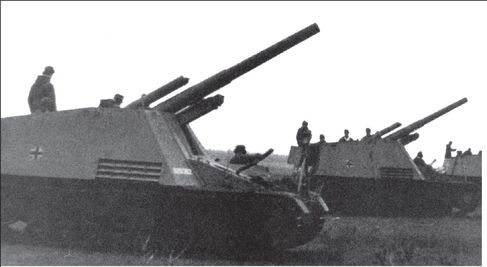
Germany's first self-propelled artillery piece based on the 15 cm field howitzer was actually designed to be only an interim solution in anticipation of vehicles based on the Panther and Tiger chassis models. These were never built as the German Army felt obliged to use the Hummel model throughout the war. It was based primarily on the Pzkpfw IV, but with a number of components from PzKpfw III, therefore the designation of model III/IV. The same layout used for the Wespe was applied to the Hummel. Considering its light armour and the little protection it afforded the crews, even from the elements, and its limited access to ammunition; the Hummel was very effective and popular. In total, 880 Hummels were built during WWII.
Production period:
1943 â 1945
Main manafacturer:
Rheinmetall- Borsig, Alkett
Tonnage:
23 tonnes
Crew:
6
Length:
7.17 meters
Width:
2.97 meters
Height:
2.81
Track width:
40 cm
Ground clearance:
40 cm
Motor:
Maybach HL120 TRM V-12 petroleum
Engine capacity:
265HP at 2600 rpm
Fuel capacity:
600 liters
Maximum speed:
25 km/h
Maximum range:
215 km
Armament:
1Ã 15 cm s.F.H. 18/1, 1 Ã 7.92 mm MG
Ammunition quantity:
15 cm â 18 shells, 7.92 mm â 600 rounds
Armour strength:
Hull frontal:
30 mm
Hull sides:
20 mm
Hull rear, roof floor:
15 mm
Turret front:
15 mm
Turret sides:
15 mm
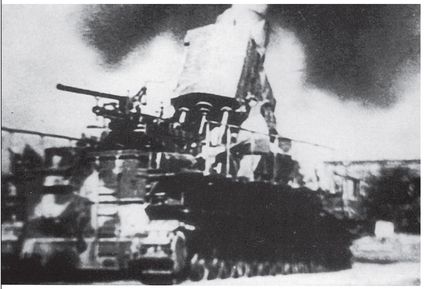
Built to give the German Army the kind of firepower which only railway borne artillery could heretofore deliver but in the field, hence motorised. Large and ungainly and barely able to move, it fired, despite all, mortar rounds which weighed close to two tons each.. Only six examples were ever manufactured, Tor, Oden, Adam, Eva, Loki and Ziu. They were used only during the siege of Sebastopol 1941 â 1942, as well as in the fighting in Warsaw. It was also described as a self-propelled howitzer.
Production period:
-
Manufacturer:
Rheinmetall-Borsig
Tonnage:
125 tonnes
Crew:
18
Length:
11.22 meters
Width:
3.2 meters
Height:
4.47 meters
Track width:
-
Ground clearance:
-
Motor:
Daimler Benz V-12 Diesel
Engine capacity:
580 HP at 2000 rpm
Fuel capacity:
- liter
Maximum speed:
10km/h
Maximum range:
-
Armament:
1 Ã 60cm howitzer
Ammunition quantity:
60 cm â 2 shells
Armour strength:
Hull frontal:
-
Hull sides:
-
Hull rear, roof, floor:
-
Turret front:
-
Turret sides:
-
Czechoslovakia's most important tank at the time of the German invasion in 1938. The vehicle was even better than the current German equivalents. This was naturally appreciated by the Germans who continued to produce the panzer until 1942. From that point on, it was produced as the basic platform for a number of special vehicles, such as the Hetzer. In total 2,000 were built between 1938 and 1942. It was exported to Sweden as model m/41.
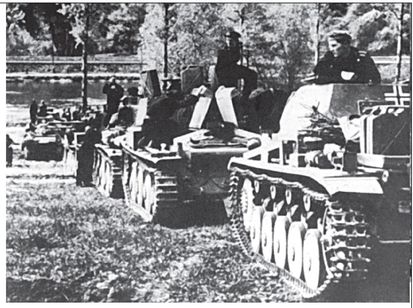
Production period:
1938-42
Manufacturer:
Praga CKD
Tonnage:
10.5 tonnes.
Crew:
4
Length:
4.9 metres
Width:
2.06 metres
Height:
2.37 meters
Track width:
29 cm
Ground clearance:
40 cm
Motor:
Praga EPA V-6 petrol
Engine capacity:
125 Hp at 2200 rpm
Maximum fuel capacity:
218 liters
Maximum speed:
42 km/h
Maximum range:
240 km
Armanent:
1 Ã 3.7 cm KwK(t)L/45
2 Ã 7.92 mm MG
Ammunition Quantity:
3.7cm â 90 shells
7.92 mm â 2500 rounds
Armour strength:
Hull frontal:
25mm
Hull sides:
10 â 15mm
Hull back, roof, floor:
10mm
Turret front:
25 mm
Turret sides:
10 â 15 mm
One of Germany's most important tanks at the beginning of WWII. Designed in 1935, in 1940 the tank was regarded as being too weak for use in an ordinary tank capacity. Instead, it came to be used as a platform for different types of mobile weaponry that did not require a turret, or for reconnaissance vehicles. Poorly armoured and poorly armed, it was, at least, light and swift and easy to manufacture. Production ceased in 1944. Approximately 2,000 models, including all its variations, were built during WWII.
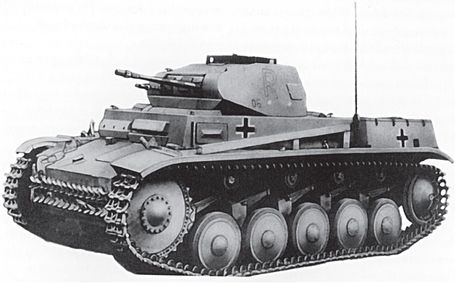
Production period:
1935 â 44
Manufacturer:
MAN, Henschel, Famo, Daimler-Benz
Tonnage:
9.5 tonnes
Crew:
3
Length:
4.64 metres
Width:
2.30 metres
Height:
2.02 metres
Track width:
30 cm
Ground clearance:
34 cm
Motor:
Maybach HL66 P 6-cylinders Petrol
Engine capacity:
180 HP at 3500rpm
Fuel capacity:
200 litres
Maximum speed:
55km/h
Maximum range:
160 km
Armament:
1 Ã 2 cm KwK 38 L/55 1 Ã 7.92 mm MG
Ammunition quantity:
2 cm â approx. 180 shells
7.92 mm â 3,525 rounds
Armour strength:
Hull frontal:
15 â 30 mm
Hull sides:
10 â 20 mm
Hull back, roof, floor:
10 â 20 mm
Turret front:
20 â 35 mm
Turret sides:
15 â 30 mm
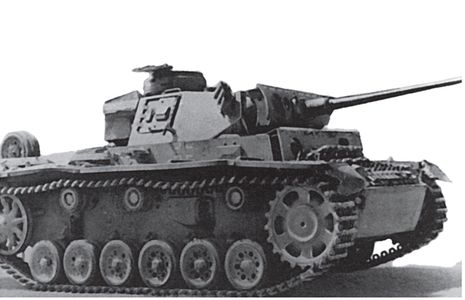
The most common medium-heavy tank in Germany between 1939 and 1942. Also used as the platform for the famous Sturmgeschutz III. Up until 1942, it was possible to upgrade the vehicle to specifications required for the battlefield. By 1942, it was no longer possible to continue furthering its development. All production was concentrated on the Sturmgeschutz. But those panzers which continued to function were still used though preferably not on the frontline where its relatively weak armour and armament were out of place. In total 1,549 model J's were manufactured.
Production period:
1942 â 43
Manufacturer:
Daimler-Benz, Alkett, MAN
Tonnage:
22.3 tonnes
Crew:
5
Length:
5.56 metres
Width:
2.95 metres
Height:
2.50 metres
Track width:
36 cm
Ground clearance:
38 cm
Motor:
Maybach HL 108 TR V â 12 Petrol
Engine capacity:
250 HP at 3,000 rpm
Fuel capacity:
300 litres
Maximum speed:
32 km/h
Maximum range:
160 km
Armament:
1 Ã 5 cm Kwk L/60
2 Ã 7.92 mm MG
Ammunition quantity:
5 cm â approx. 99 shells
1 Ã 7.92 mm 2,700 rounds
Armour strength:
Hull frontal: 50 â 80 mm
Hull sides: 20 â 40 mm
Hull back, roof, floor 10 â 20 mm
Turret front: 50 â 80 mm
Turret sides: 20 â 40 mm
According to many, the War's most acclaimed and renowned panzer. It was Germany's first assembly line heavy tank. A monster, armed with the famous 88 and for its time, (1942) it had extremely dense armour protection. Hardly upgraded during the war, it was not as indomitable a foe in 1945 as it had been in 1942, albeit still a tough nut for allied forces to crack, nonetheless. In total, approximately 1,350 were built during the war.

Production period:
1942 â 1944
Manufacturer:
Henschel
Tonnage:
56.9 tonnes
Crew:
5
Length:
8.24 meters
Width:
3.73 meters
Height:
2.88 meters
Track width:
72 cm
Ground clearance:
47 cm
Motor:
Maybach HL210 P 45 V-12
Bensin (H), Maybach HL230 P 45 V- 12 Bensin (E)
Engine capacity:
650 HP at 3000rpm
Fuel capacity:
534 liters
Maximum speed:
38 km/h
Maximum range:
90 km
Armament:
1 X 8.8 cm Kwk 36 L/56,
2 X 7.92 mm MG
Ammunition quantity:
8.8 cm â 92
shells, 7.92 mm â 3,600 rounds
Armour strength:
Hull frontal:
80 â 102 mm
Hull sides:
60 â 80 mm
Hull back, roof, floor:
15 â 25 mm
Turret front:
80 â 110 mm
Turret sides:
60 â 80 mm